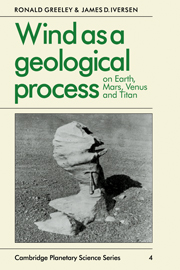Book contents
- Frontmatter
- Contents
- Preface
- 1 Wind as a geological process
- 2 The aeolian environment
- 3 Physics of particle motion
- 4 Aeolian abrasion and erosion
- 5 Aeolian sand deposits and bedforms
- 6 Interaction of wind and topography
- 7 Windblown dust
- Appendix A Nomenclature and symbols
- Appendix B Small-scale modeling of aeolian phenomena in the wind tunnel
- Glossary
- References
- Index
7 - Windblown dust
Published online by Cambridge University Press: 16 November 2009
- Frontmatter
- Contents
- Preface
- 1 Wind as a geological process
- 2 The aeolian environment
- 3 Physics of particle motion
- 4 Aeolian abrasion and erosion
- 5 Aeolian sand deposits and bedforms
- 6 Interaction of wind and topography
- 7 Windblown dust
- Appendix A Nomenclature and symbols
- Appendix B Small-scale modeling of aeolian phenomena in the wind tunnel
- Glossary
- References
- Index
Summary
Introduction
Dust. It gets in our eyes, our shoes, even in our lungs, sometimes causing disease to those who breath it. Dust storms cause visibility problems on highways, resulting in many accidents and deaths each year. And soil erosion is a major worldwide problem where surfaces are disrupted through cultivation, overgrazing, mining, construction, vehicular traffic, or other activities which disturb the surface or destroy vegetation cover.
Dust storms are common on both Earth and Mars. Although many storms on Earth reach sizes that can be seen on photographs taken from orbit, they do not become global in extent, as some do on Mars. Nonetheless, the great North American dust storm of 12 November 1933, covered a region greater than the combined areas of France, Italy, and Hungary (Goudie, 1978), and for the people involved in the dust storm, it might just as well have been global.
The dust storm of November 1933 is an example of a storm caused by an area of extreme high pressure and strong barometric pressure gradient. It covered the region southward from the Canadian border, stretching from Montana to Lake Superior, and to the western Ohio and lower Missouri River valleys (Hovde, 1934; Miller, 1934). That year a severe drought was experienced over the northern and central Great Plains, and crop and pasture grass failures left the soil exposed to the wind. Maximum recorded wind velocities on 12 November were 25 m/sec at Bismarck, North Dakota, and at Davenport, Iowa.
- Type
- Chapter
- Information
- Wind as a Geological ProcessOn Earth, Mars, Venus and Titan, pp. 250 - 281Publisher: Cambridge University PressPrint publication year: 1985



